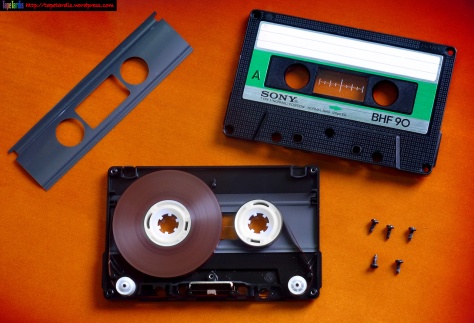
Firstly, I should mention that this is not the 1983 BHF 90 I photographed previously (or indeed the 1981). This is another variant with a few small detail differences from the ’83. I got it from a friend, and I can’t confirm an approximate date of purchase, but it’s almost certainly a little later than the ’83 – maybe from later the same year, or from 1984. Whichever is the case, it’ll be from the BHF 90’s swansong period, not long before the range was heavily revamped and reconstituted (the rough replacement was the HF). If you compare this tape’s label with that on the 1984 UCX 60, you’ll see they match in terms of detail and are obviously from the same period.
With that explained, let’s move onto the elephant in the room – the fact that I’ve dismantled the cassette. The BHF 90s were Type 1 ferric oxide tapes – serving as an intermediate step between the most basic quality CHF and the superior quality AHF. You can clearly see the reddish-brown colouring of the tape reel – a very different colour from chromium dioxide, which would appear very dark, almost blueish grey.
The next thing you notice is how simple the mechanics are. The tape transports from one reel to the other, guided by very basic moulded posts, and plastic wheels. And at the centre of the outstretched tape sits a soft, spring-suspended pad, which gently pushes the audio media onto the record/play heads once in the machine. Behind the soft pad there’s a metal shield to isolate the magnetic activity to the tape. You can also see the two slip sheets (designed to reduce drag on the revolving reels) – one of which I’ve taken right out of the casing.
Five black Phillips-head screws hold the whole thing together.
But of course, economically, compact cassettes had to be simple. These BHF 90s would retail at less than £1, and they were a name brand product, set a cut above the base level. Basics would be significantly cheaper, so there wasn’t much to play with when it came to costing out the design.
As I was discussing in the previous post, the mid 1980s would see factory-applied, stick-on labelling steadily disappear from many audio cassettes. The next generation of Sony tapes came with much smaller factory-applied branding/ID labels, plus a set of write-on labels that users could apply themselves. And over the next few years, most blank cassettes dropped factory labelling altogether, as manufacturers simply stamped their branding directly onto the plastic casing.
This early ‘80s generation, however, had full-sized, integrated labels applied at the factory, and the brushed metallic effect on this cassette’s label was something that seemed a luxury for the price – even at the time.
So… I suppose I’d better go and put it back together now…

